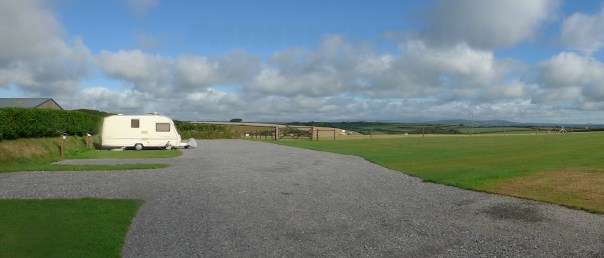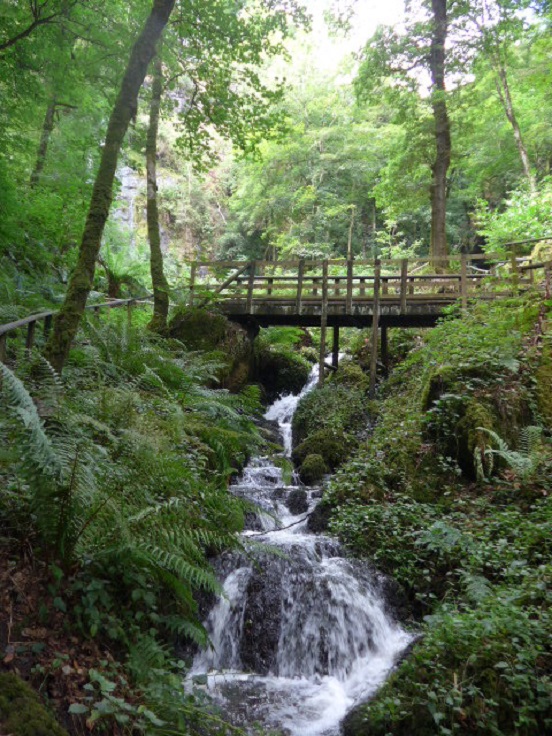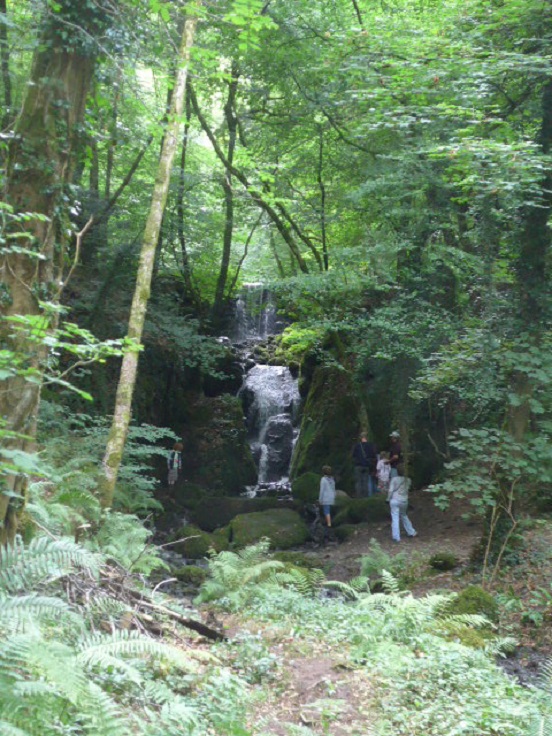Friday was departure day for our annual holiday my two girls, grandson and I spend together.. This year, they rented a ‘cottage’ in Devon. The ‘cottage’ turned out to be a three bedroom, two bathrooms house overbooking the bay at Bigbury-on-Sea on the south Devon coast. And just up the road, in the next village there was a Club CL that had space for my van.
All of my long journeys invariably begin with a drive along on the M25 in one direction or the other so I left home at six in the morning to avoid the worst of the traffic. By 08.45 I’d reached Stonehenge so I pulled into their car park for a coffee break and rest. Because I’m a member of English Heritage I took advantage of the free admission and travelled on the coach to visit the stone circle.
Within the hour I was on my way and didn’t stop again until I reached the site.
My pitch was at Chapelcombe Farm in St. Ann’s Chapel. It’s a working farm concentrating mainly on sheep. Their licence must be for more than a Club CL because my pitch was number seven with No.8 and No.9 going along into the corner of the field. Each pitch has it’s own water supply, dustbin and electric supply point. Toilets and showers are provided in one of the out-buildings of the farm although the showers are charged for on a meter. Some of the pitches are on manicured lawn whilst mine and four others are on gravel. Presumably the gravelled pitches are the CL.
From all the pitches there are extensive views across the countryside to the hills of Dartmoor in the distance. Site fee is £14.50 per pitch per night. In my view, for a site by the sea in August, it is excellent value.– even more so for the family of five on the next pitch.
But the local roads!…………… They are a nightmare for driving. Especially towing to the site from the A38 trunk road. Most of the roads are narrow, high hedged single lanes, with passing places every 300 yards or so. My advice to anyone visiting the area is to ignore your sat-nav, research a route using maps and Google Earth and write it down.
On Saturday my daughters and grandson arrived and they quickly settled in to their ‘new home’. In the evening they called for me at the site and we went along to the Pickwick Inn for dinner.
The Inn is situated at the cross-roads in the village and is only a short walk from the site. The Pickwick Inn is a Grade 2 listed building because although the frontage was built in the 19th century, the rear of the pub includes what was once a 15th century chapel and part of a 17th century house.
0-0-0-0-0-0-0-0-0-0
For our first day out we drove to Torcross then on to Dartmouth. I decided to try the short cut and fortunately the tide was out. By taking the Tidal Road one saves a detour of four to five miles. The road runs alongside the river but as the tide comes in, parts of the road goes under the water. We very soon arrived at Torcross, the village at one end of Slapton Sands. In December of 1943 the village was evacuated and the whole area was given over to the American Army as a battle training ground in preparation for the Normandy landings. In the car park is an American Sherman tank which was dragged from below the surface of the Bay.
It has been erected as a memorial to 940 American soldiers who lost their lives during a disastrous pre- D-day training exercise during one night in April of 1944.
After a lunch and a couple of hours on the beach, we continued on our journey to Dartmouth where I was able to park quite close to the Castle. Dartmouth Castle came into being during the 1380’s when it was thought that the town was likely to be attacked by the French. During Henry VIII’s reign, because of his break with the Church of Rome and because all the countries of Europe were threatening war against England, the Castle was enlarged and given artillery towers and an iron chain which could be stretched across the estuary to a tower on the far bank. During the Napoleonic wars the Castle was again further strengthened.
The Castle is now in the care of English Heritage.
0-0-0-0-0-0-0-0-0-0
We had a birthday to celebrate during the morning so we spent the time in the conservatory until lunch time. During the afternoon we walked across the sands to Burgh Island.
The Island is around 400 yards from the mainland with about 700 yards of sandy beach between the two water lines. At high tide the water is up to seven feet deep on the causeway.
The tide changes rapidly and should you find yourself marooned because of the rising water, you can always pay to have the sea-tractor ferry you across to the main-land.
On the Island is a 13thCentury Inn – The Pilchard so named because in the 1800’s fishermen caught vast numbers of pilchards around the Island, stored them in barrels of salt and sent them to market. After several years the pilchard stocks diminished so that now, pilchards are rarely seen in these waters.
The other building on the Island is the Hotel. In the late 1920’s the Island was bought by Archibald Nettlefold, a film producer and the then owner of Walton Film Studios. He built a grand hotel in the latest ‘30’s style with palm court and sumptuous suites. Among his frequent guests were the likes of Agatha Christie, Noel Coward, the Duke of Windsor and Mrs Simpson. The hotel is open to dinner guests starting at £75 per person however, dinner is included in an over-night stay. Each suite can be had for £750 per night.
0-0-0-0-0-0-0-0-0-0
Today we set off down the A38 for a few miles before turning off towards Dartmoor to visit the estate on which there is the Canonteign Falls. The estate used to belong to Viscount and Lady Exmouth and in 1890 after the closure of the estate’s silver mines, the redundant miners were set to work building a man-made waterfall with leats to power various water driven machines on the estate. The waterfalls are the highest man-made falls in England, measuring 70metres high.
I persevered through the woods and upwards to the base of the falls, but then a long arduous climb continued via ninety uneven steps which takes you on a circuitous climb round the top of the falls and back down on a different route. I settled for the walk to the base of the falls, leaving daughters and grandson to do the climb and circular walk..
0-0-0-0-0-0-0-0-0-0
We decided on another beach trip today. This time to the National Trust beach and car park at South Milton. Fortunately we arrived early enough to secure one of the remaining parking places. Others who arrived later queued on the road for a space. Others set off on the long trek back to find another beach. After lunch the family took a walk along the cliff coastal path whilst I took a nap. The view inland from the car park was as equally beautiful as that looking out to sea. In the evening we drove to the next village where we found another lovely little pub to have dinner.
0-0-0-0-0-0-0-0-0-0
On Friday I programmed the Tomtom with the coordinates for a car park at Salcombe. We set off down the hill to the Tidal Road only to find that the water was still too deep to allow us to cross without damage to the car.
We waited for fifteen minutes or so as we watched the water line recede. Finally I drove through three inches of water for a hundred yards or so. Thirty minutes later we arrived at the car park where we found it ¾ full. It filled rapidly quite quickly after our arrival. With very little of the beach being exposed, the girls and Sam set out to have a walk. I was quite content to sit on the sea wall doing some people watching. But not for long. Within minutes a helicopter flew into the bay where it hovered above our heads
and then began to descend, filling our eyes with blown sand. The machine settled on the grass alongside the car park where the rotor finally stopped and doctor and paramedics jumped out and ran across to the restaurant and beach shops. After twenty minutes or so an ambulance also arrived and after quite some time, a youngish chap was stretchered out and with heart monitor balanced across his middle he was loaded into the ambulance. After a further delay the medical team returned to their helicopter, standing around finishing their huge ice cream cornets before boarding and taking off, leaving us to hang onto our hats and shielding our eyes from the violent down draught.
Later in the evening we adjourned to the Pickwick Inn for a final meal before preparing for the journey home the next day.
0-0-0-0-0-0-0-0-0-0
As I drove home towards Stonehenge, I decided to do a small detour. The British Army has had a presence on Salisbury Plain for more than 120 years but after World War-1 the War Office began buying up huge tracts of land so becoming the landlord to many farmers. The ground they purchased also included Imber, an ancient, isolated village with a 13th Century church set in the centre of the Plain. So all the villagers became tenants of the War Office. In 1943 villagers and farmers all received letters telling them that within 43 days, they must leave their properties.. The date by which everyone had to be gone was just one week before Christmas. No one other than military personnel has been allowed into that part of the Plain for many years, hence it’s the only area in the Country without post codes. But recently without any public announcement, the Ministry of Defence has allowed access to the village church for one week during August. I was curious to see what had become of the remote village.
The church was built in the 13th Century and stands on an earlier building from the previous century.
At one time it was rich in fittings and furnishings however most have been removed and scattered among other churches in Wiltshire. The building is now just a shell however the army has kept it in a reasonable state of repair with the bell tower still functioning. Because of some 13th and 15th Century wall paintings which are still faintly visible on the walls, in 2005 the church was given a Grade 1 listing and its care and preservation was handed to The Churches Conservation Trust.
As for the rest of the village, most of the once thatch-roofed cottages have been pulled down and replaced with groups of skeleton houses built without windows and doors and roofed with pressed steel roofs.
Likewise the former manor house has had its windows and doors boarded up. A third floor built into what was once a dormered roof has also gone, to be replaced by a factory-like steel roof .
The ‘village’ is now used by special forces as a training ground for simulated house to house combat.
0-0-0-0-0-0-0-0-0-0























